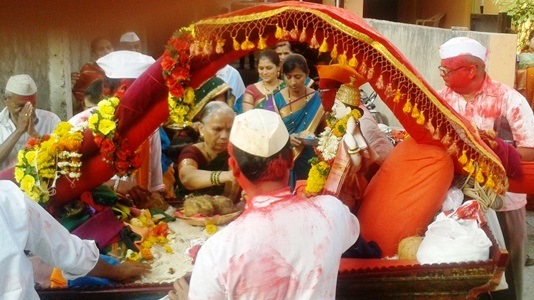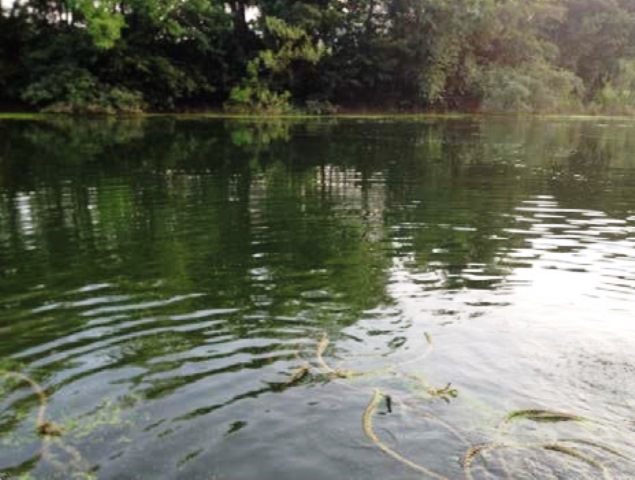The Krishnabai Utsav, a festival celebrating and revering the river Krishna as it flows through Wai, begins tomorrow in the town of Wai in Satara district in Maharashtra. This is not a new thing though. The Krishna Mai/ Bai (meaning mother Krishna) river festival is celebrated here every year as the river has a long history intertwined with the development of the town as well as the everyday lives of the people.
Wai taluka has seven ghats on the Krishna's banks--Gangapuri, Madhi Aali, Ganpati Aali, Dharmapuri, Brahmanshahi, Ramdoh Aali and Bhimkund Aali. The story behind the celebration of the Krishnabai festival goes to the times of the Maratha rule. When warlord Afzal Khan set out from Wai to attempt to defeat the great Maratha warrior King Chattrapati Shivaji, Shendye Shastri of Wai prayed to the Krishna River for Shivaji Maharaj's victory, sparking the Krishnabai festival. It is celebrated on each ghat for four to eight days.

During the festival, an idol of the River goddess Krishna is carried around in a palanquin in a procession complete with drums, lezim (a traditional group dance performed during processions) and gulal (a red coloured powder thrown on the procession) through all the lanes of each of the ghats where people, all dressed up and ready for the festivities, offer their prayers to the river goddess. This is followed by distribution of the prasad or the offering by each house, and then lunch. The evenings are marked by different cultural programmes on the banks of the river for the next eight days.
Indeed, the River Krishna is one of the important rivers flowing through Maharashtra and has a tremendous religious and cultural significance. It is the fourth biggest river in terms of water inflows and river basin area in India, and is a major source of irrigation for Maharashtra, Karnataka, Telangana and Andhra Pradesh. The river originates in the western ghats at Mahabaleshwar near Jor village and flows through Wai, which is often referred to as Dakshin Kashi because of the large number of ancient and historic temples in the city as well as its importance as a cultural and religious centre in the state.
The state of the river today
Unprecedented rise in population and the vagaries of the development processes that have led to increasing amounts of pollution, encroachment and exploitation of its waters due to industries, sewage released from cities, faulty cropping practices such as water guzzling sugarcane plantations and reduction in flows of rivers due to damming have left the river in a sorry state. A report by the MPCB on the state of rivers in Maharashtra has found that the Krishna river basin is one of the most polluted with consistent bad quality reported at all monitoring stations.The stretch of the river that flows through Wai and five other towns has been found to be among the 302 most polluted river stretches in the country, categorised as priority II because of its high biochemical oxygen demand.

"I was aghast when I saw the current state of the river, though I am a frequent visitor of Wai", says Makarand Shende, an architect in Pune and originally a resident of Wai. He started an organisation named SAMOOH (Saman Moolabhoot Hakka meaning equal rights for humanity as well as ecosystems) that includes a group of professionals and youngsters from Wai and Pune and who are trying to do their bit to save the river.
"I remember my days in Wai as a young boy, our life was associated with the river. We played on the river ghats, even my school was on the banks of the river, we used to have so many celebrations and festivals on the river ghats. I remember plunging into the doha (deeper section of the river) of Krishna Mai as a child, but she did not look like this then. She now resembles a gutter full of grass and I decided that I had to do something about it", he says.
The construction of two dams at Dhom in 1978 and more recently at Balkawadi have altered the course of the river and also reduced its flow resulting in heavy siltation and stagnation. As the river resumes its flow further downstream in the city of Wai, it gets further polluted due to waste including plastics and untreated sewage that is released into the river.
Attempts to rescue the river
"The dam wall has disconnected the original route of the river resulting in a 2 kms dead patch near Dhom and this part of the river does not have any support other than natural water coming through a live stream (Gomukh) from the temple", says Shende. "This has resulted in stagnation and pollution of the entire 2 kilometres patch of the river which was full of weeds and hydrilla earlier. This patch had approximately 25 crore litres of unused and dead river water!"
"I went back to Pune with the thought of what I could do about this situation and returned back to Wai with a camera in May 2014 and moved around in the place and saw the situation of the river. I kept thinking of who could be approached for this, and if the government needed to be asked by filing for an RTI". "I met a number of people such as activists, government officers, friends who told me that I could only start to work if I was not afraid of failure and I could be alone on the way".
"Incidently, we had a lecture on the history of the Wai ghats where the sad state of the river was discussed and that the ghats would be destroyed if nothing was done about them". "This strengthened my resolve further", informs Shende.

He along with others from SAMOOH decided to first start work on the Dhom Pachwad, a 25 kilometre patch of the river, and to clean the Dhom Kund. Around 20 to 25 people from SAMOOH along with people from the village who were motivated to rescue the river and support the initiative got together and decided to clean the stretch of the river and help her flow freely.
A total of 60 to 70 people managed to get a JCB and 20 to 25 tractors. People from the Katkari tribe in the village who were experts in getting in the water also decided to contribute and got into the water with logs of wood for support to painstakingly remove the weeds, sand and silt. They were able to clear an area of 500 by 300 feet and only needed around Rs 20,000 for this effort as most of the labour cost was covered through public participation (shramadaan).
Is the effort sustainable?
"We plan to continue doing this to further clear the river of weeds and silt through the involvement of the community", says Shende. "This is not the end though and is not enough", he adds, "This should be looked at as a beginning to achieving some long term and short term goals. We do not want to limit ourselves to private activities, we also plan to act as a pressure group to direct attention of the government to the broader issue of the sustainable development of the river as a whole and also see that public money is spent well".

For example, when a project to construct a concrete pipeline was proposed at Ganapati ghat, SAMOOH along with the villagers pressured the authorities to see that this was not only done as a cosmetic exercise. They are now focusing on a Rs 25 crore project to ensure proper treatment of the 5 MLD sewage generated at Wai.
They were also successful in inviting Stockholm Water Prize winner Rajendra Singh who came to Wai during the Krishna River Utsav last year. This helped further in getting everyone from the village together, as well as support from the authorities. Efforts made by SAMOOH have also helped in including Dhom village in the Jalayukt Shivar Yojana with the aim to revive the river Krishna.
SAMOOH has been successful in encouraging villagers and the Gram Panchayat at Dhom to open a bank account in the name of the river Krishna to raise funds for the regular cleaning of the river. The village community has been successful in gathering around Rs 1,50,000 and have successfully cleaned another 1000 feet of the river, an effort that they plan to continue doing as a responsibility of the village and the community.
"If it would be possible to revive the patch of the river near the dam and plan towards sustainable development of the river and its surroundings and even go far as promoting eco tourism to make this development sustainable in the long run, then I think this can help in developing a river centric city model in the long run". "We need a holistic and coordinated approach where all need to do their own bit. We at SAMOOH are determined to take this forward, else the death of the river is inevitable", says Shende.













